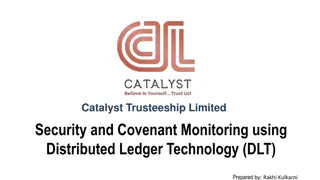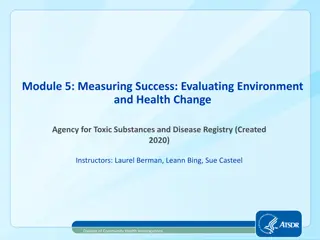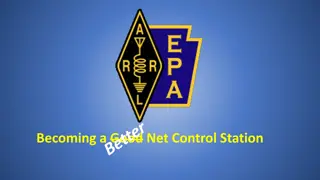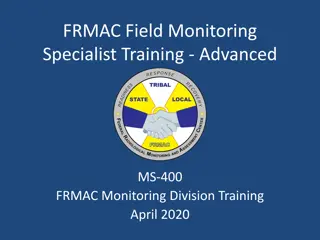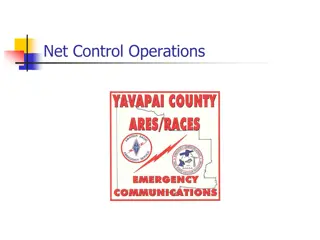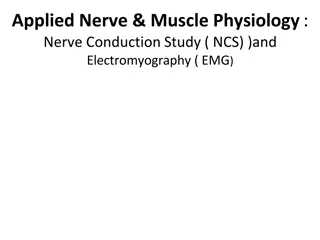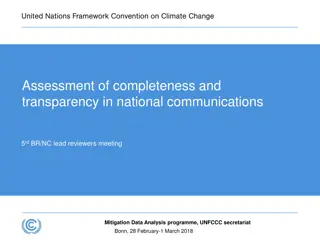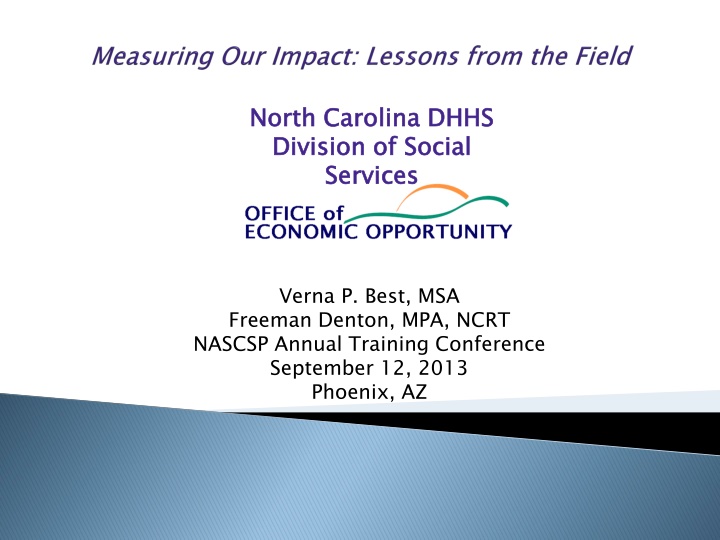
Improving Community Support Services for Low-Income Families
Discover how the North Carolina DHHS Division of Social Services utilizes the CSBG funding to provide essential services to low-income families, focusing on self-sufficiency, eligibility criteria, and key outcomes. Learn about the different service delivery models, partnerships, and effectiveness measures aimed at lifting families out of poverty.
Download Presentation

Please find below an Image/Link to download the presentation.
The content on the website is provided AS IS for your information and personal use only. It may not be sold, licensed, or shared on other websites without obtaining consent from the author. If you encounter any issues during the download, it is possible that the publisher has removed the file from their server.
You are allowed to download the files provided on this website for personal or commercial use, subject to the condition that they are used lawfully. All files are the property of their respective owners.
The content on the website is provided AS IS for your information and personal use only. It may not be sold, licensed, or shared on other websites without obtaining consent from the author.
E N D
Presentation Transcript
North Carolina DHHS Division of Social Services North Carolina DHHS Division of Social Services Verna P. Best, MSA Freeman Denton, MPA, NCRT NASCSP Annual Training Conference September 12, 2013 Phoenix, AZ
So let's be honest with ourselves and not take ourselves too serious, and never condemn the other fellow for doing what we are doing every day, only in a different way. Will Rogers Primarily used to fund 8 Service Delivery Models (Self Emergency Assistance, Information and Referral & Income Maintenance) Limited use for Administrative Support of Other Programs Discretionary restricted to Limited Purpose Agencies Reserves 5% for CSBG Administration Self- -Sufficiency Sufficiency, Employment, Housing, Education, Nutrition,
35 Community Action Agencies 4 Limited Purpose Agencies (Outcomes vary significantly) 9 State Level Staff (1 ROMA NPtP Certified Trainer/3 In-Progress) Active State Association(2 ROMA NPtP Certified Trainers/1 In-Progress)
Self-Sufficiency (comprehensive case management) mobilizes CSBG funding for direct service provision to low-income families while also leveraging dollars with other agency and community resources. Affords us a methodology to demonstrate 1) CSBG s effectiveness of changing people s 2) Scaled participant progress 3) Framework for creating meaningful collaborations/optimal partnerships 4) Usage for direct service provision not solely for administrative purposes
Eligibility Eligibility based on 100% 100% of the Federal Poverty Guidelines Standard Measures Performance: activities designed to remove them from poverty Efficiency: designed to remove them from poverty Key Outcomes: The number of low-income families rising above the poverty level The average change in annual income per participant family The number of participants obtaining employment The number of jobs with medical benefits obtained The participant average wage rate The number of participants completing education/training programs The number of participants securing standard housing The number of participants provided emergency assistance Standard Measures Performance: #of low-income families participating in comprehensive Efficiency: $per family participating in comprehensive activities Key Outcomes:
The number of families participating in and/or receiving comprehensive services designed to remove them from poverty 5076 The number of low-income families rising above FPG 702 The number of participants obtaining employment The number of participants obtaining better employment 789 219 The average change in annual income The participant average wage rate The number of participants obtaining jobs with medical benefits The number of participants completing education/training programs The number of participants securing standard housing The number of participants provided emergency assistance $7,288 $9.05 220 897 312 994
No standard methodology to capture ROI to really make the numbers tell a more comprehensive and convincing convincing story
Monthly Financials (includes performance objective) Specific to CSBG funding Quarterly Performance Reports Specific to CSBG funding Year-End Report of State Contracted Outcome Specific to CSBG funding CSBG-IS Agency wide/ inclusive of all funding streams
Context Matters Monitoring and Verification Timely and Consistent Guidance ROMA Cycle vs. Numbers Only Establishing Expected Achievement Rates (80%-120%) Local, Regional and Statewide Considerations Ask Questions Tell the Story Simply
ROMA Training for NCs CSBG Sub-Grantees 5 Certified NPtP ROMA Trainers Development of AR4CA (Accountable Results for Community Action) Regional Self-Sufficiency Seminars Strengthened review and guidance for monitoring and reporting (CSBG-IS and state specific)
5 network staff became NPtP Certified in 2012 Additional State and Association Staff Seeking NPtP Certification OEO/NCCAA sponsored NPtP ROMA Certification Performance Management vs. Performance Measurement Engaged in Center of Excellence Efforts Exploring Data Dashboards Sound Management Practices vs. Reporting
North Carolina DHHS Division of Social Services North Carolina DHHS Division of Social Services Verna P. Best Verna.Best@dhhs.nc.gov 919-527-6251 Freeman Denton Freeman.Denton@dhhs.nc.gov 919-527-6254










